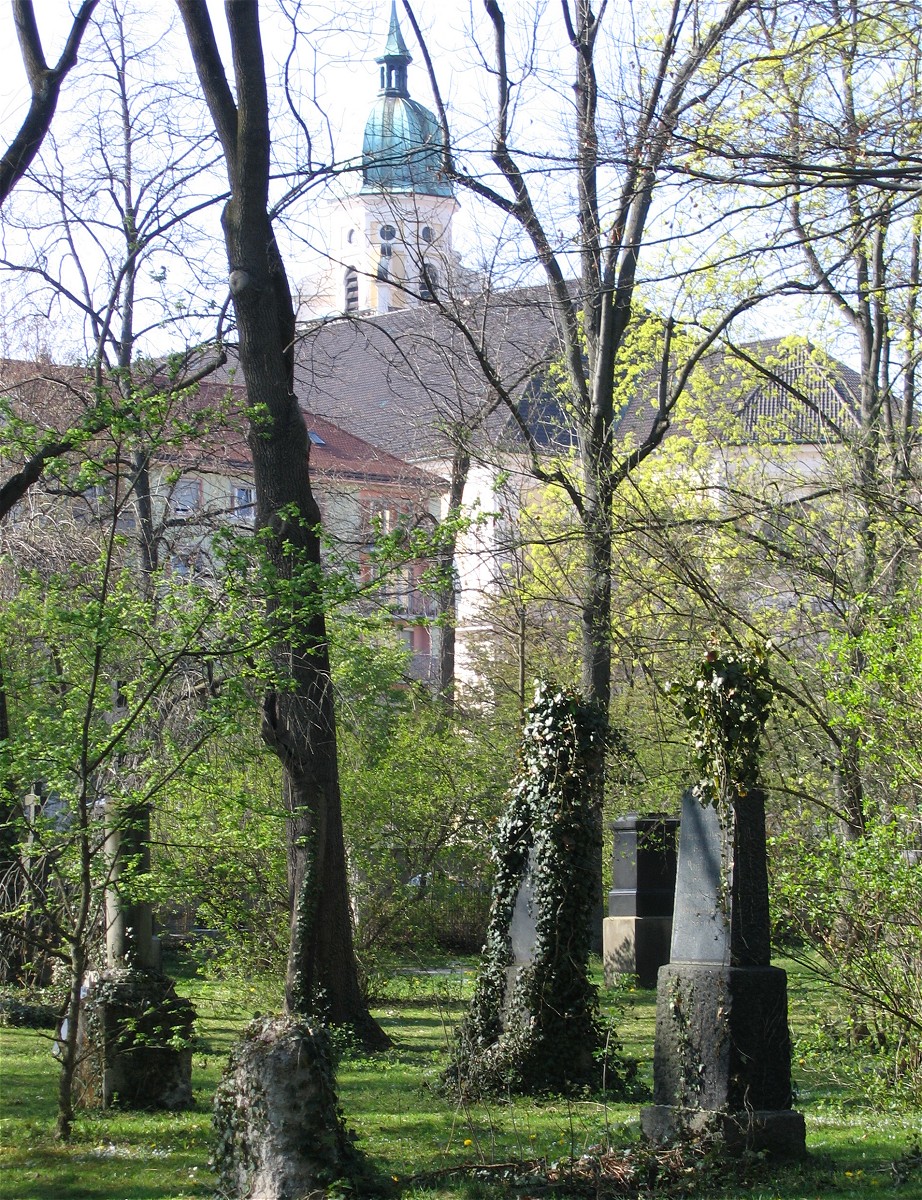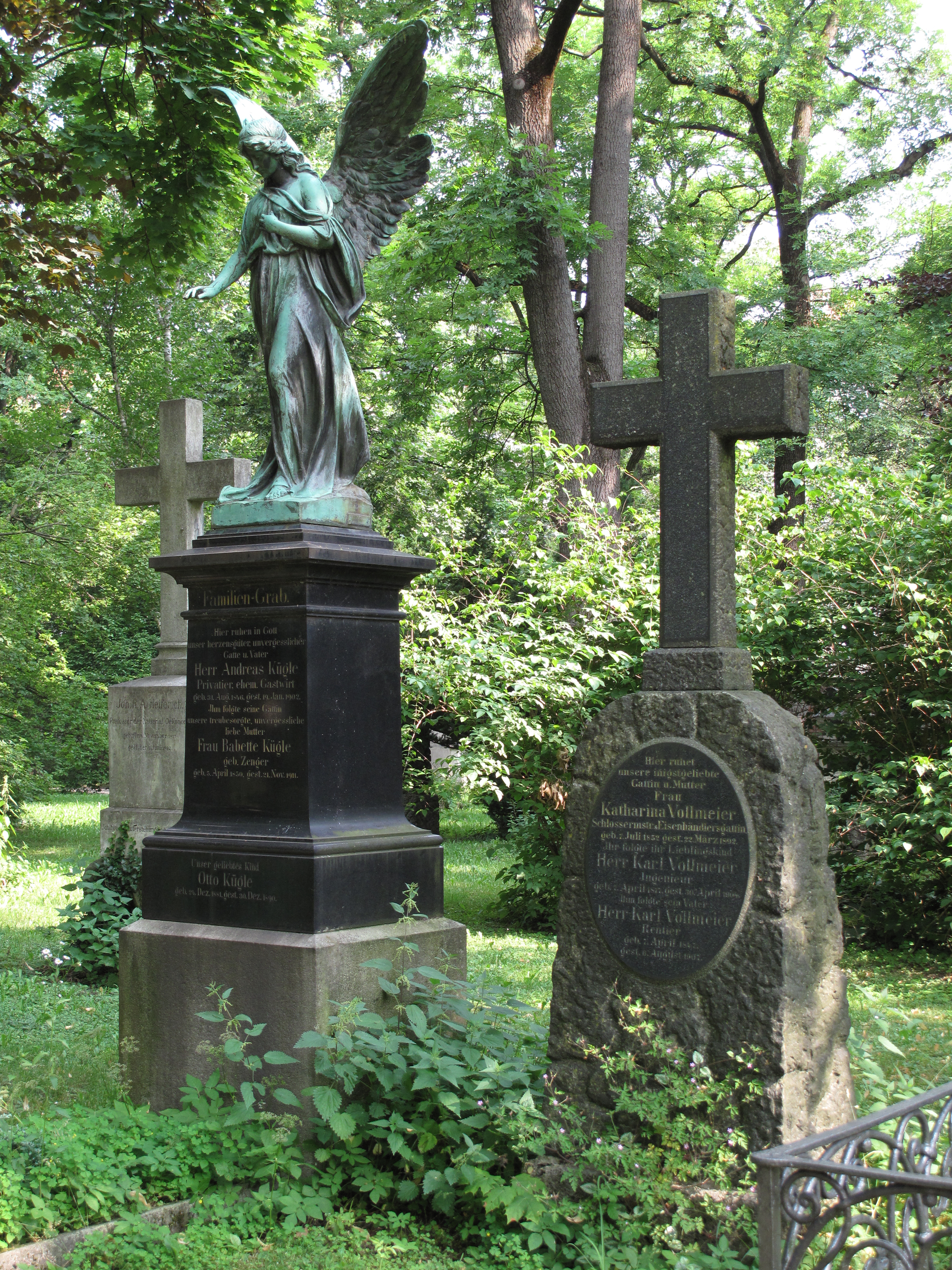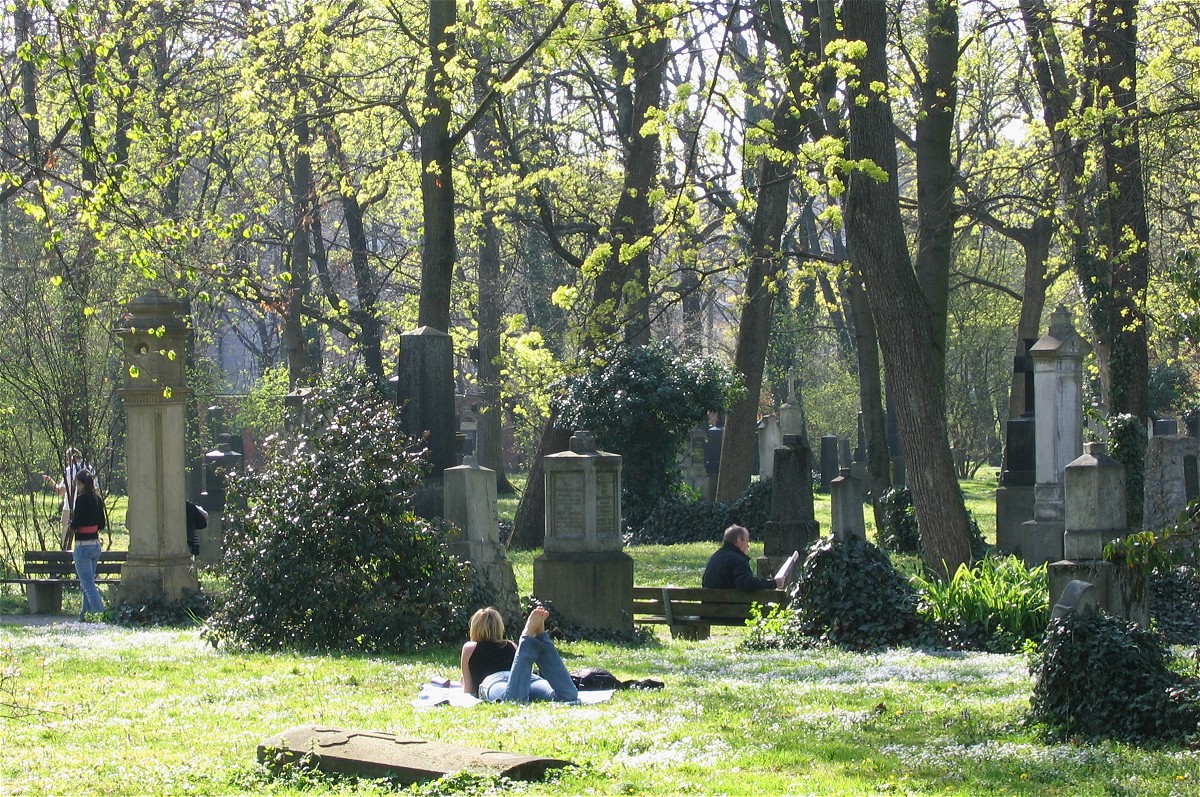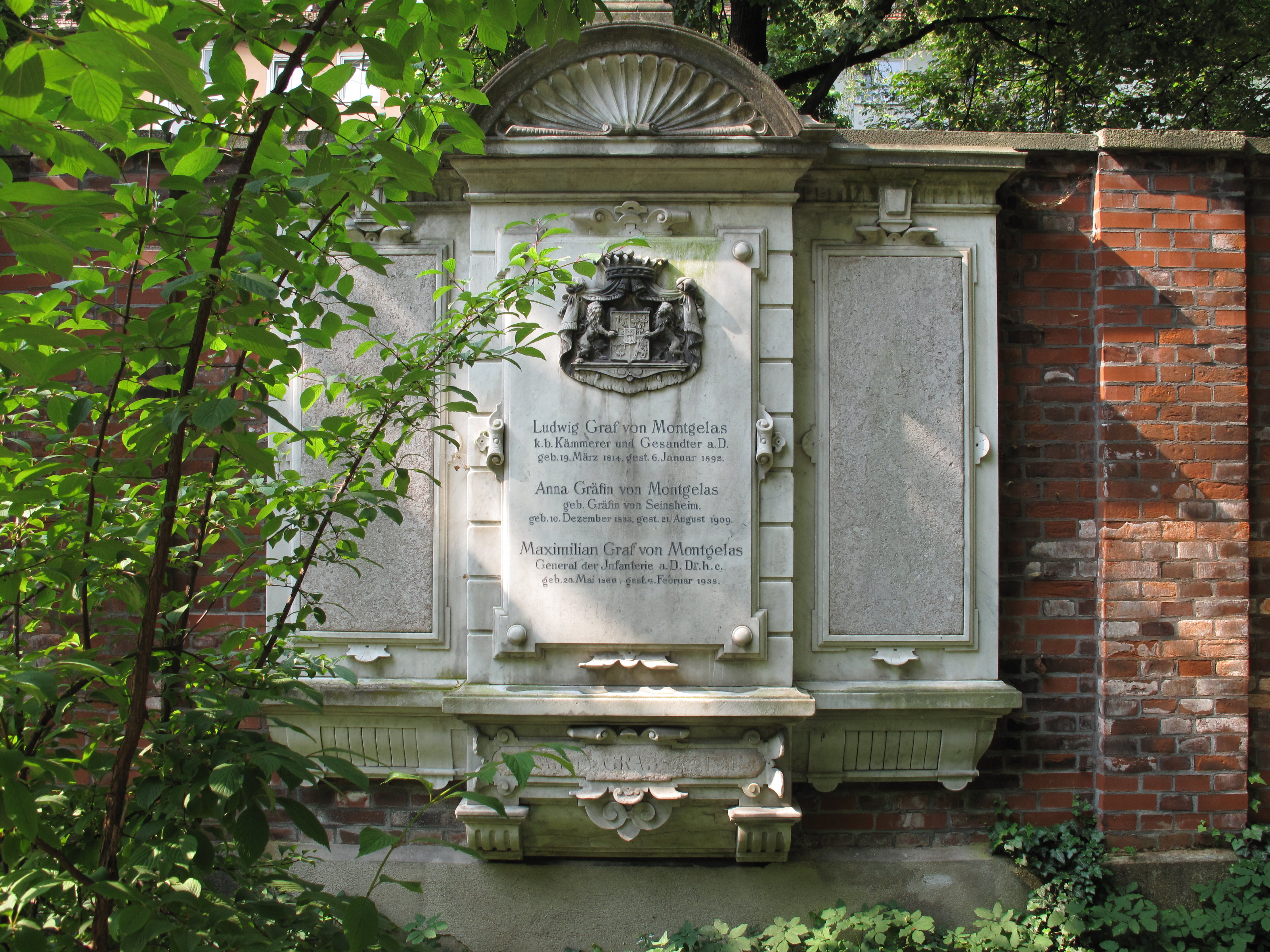Alter Nordfriedhof (Munich) on:
[Wikipedia]
[Google]
[Amazon]

 The Alter Nordfriedhof ("Old North Cemetery") is a former
The Alter Nordfriedhof ("Old North Cemetery") is a former
 The Alter Nördlicher Friedhof, with its light planting of trees, today represents a significant green space in the Maxvorstadt district and is used as a small park, with due respect for those long since buried here. Many benches have been installed. On fine days the grass between the ivy-covered gravestones is popular for sun-bathing. The path round the inside of the wall and the arcades is much used by joggers: a single circuit round the four hectare space is about 750 metres.
The playground that adjoins to the west is used among other things for ball games, and also for ground chess.
The Alter Nördlicher Friedhof, with its light planting of trees, today represents a significant green space in the Maxvorstadt district and is used as a small park, with due respect for those long since buried here. Many benches have been installed. On fine days the grass between the ivy-covered gravestones is popular for sun-bathing. The path round the inside of the wall and the arcades is much used by joggers: a single circuit round the four hectare space is about 750 metres.
The playground that adjoins to the west is used among other things for ball games, and also for ground chess.
 *
*
City of Munich official website: Alter Nordfriedhof
München-Wiki: Alter Nördlicher Friedhof
Fotogalerie: Erholung im Alten Nördlichen Friedhof
Friedhöfe in München - Alter Nördlicher Friedhof
{{Authority control Cemeteries in Munich Parks and open spaces in Munich Maxvorstadt

cemetery
A cemetery, burial ground, gravesite or graveyard is a place where the remains of dead people are buried or otherwise interred. The word ''cemetery'' (from Greek , "sleeping place") implies that the land is specifically designated as a buri ...
located in the Arcisstrasse in Maxvorstadt, Munich
Munich ( ; german: München ; bar, Minga ) is the capital and most populous city of the States of Germany, German state of Bavaria. With a population of 1,558,395 inhabitants as of 31 July 2020, it is the List of cities in Germany by popu ...
, Bavaria
Bavaria ( ; ), officially the Free State of Bavaria (german: Freistaat Bayern, link=no ), is a state in the south-east of Germany. With an area of , Bavaria is the largest German state by land area, comprising roughly a fifth of the total lan ...
, Germany
Germany,, officially the Federal Republic of Germany, is a country in Central Europe. It is the second most populous country in Europe after Russia, and the most populous member state of the European Union. Germany is situated betwe ...
. It is not to be confused with the Nordfriedhof in Munich, which was set up only a short time later in Schwabing. Construction began in 1866 to designs by the city architect Arnold Zenetti.
History
Until the middle of the 19th century the city of Munich had only a single public burial ground, the presentAlter Südfriedhof
The Alter Südfriedhof (''Old South Cemetery'') also known as "Alter Südlicher Friedhof" is a cemetery in Munich, Germany. It was founded by Duke Albrecht V as a plague cemetery in 1563 about half a kilometer south of the Sendlinger Ga ...
. This was growing too small however for the rapidly growing city, and planning therefore began for a new burial ground in the north of the city.
Between June 1866 and the summer of 1869 the Northern Cemetery ("Nördlicher Friedhof") was built in Maxvorstadt.
The planning process itself reflected the split in society regarding cemeteries and public buildings generally: on the one hand there was a general wish to have the most prominent grave site possible, but on the other hand an equally general feeling that the cemetery should not be at one's own front door. Despite all controversies the Alter Nördlicher Friedhof opened on 5 October 1868, and the first burial took place the same day, when the remains of the former minister of St. Ludwig's, Munich, were transferred to the new burial ground.
The cemetery itself, rectangular in shape, with the chapel and various service buildings annexed, was originally divided into 16 fields of equal size. Along the west wall 30 arcaded vaults were built; a large cross stands in the middle. In its geometrical ground-plan and to some extent the arcades along the wall it resembled the idea of the Campo Santo, at the time a popular style of burial ground in Germany.
With the rise to power of the National Socialists in 1933 the entire existence of the cemetery was thrown into doubt: the new regime, in the context of the re-building of Munich as the capital of the movement, wanted to connect Isabellastraße with Luisenstraße in order to construct a spectacular boulevard, which was obstructed by the Alter Nördlicher Friedhof. For this reason burials ceased in 1939. Up to 1944 there were still single burials in existing family graves. After that time the cemetery was badly affected by air raids and was closed altogether. Many of the arcade vaults and most of the other cemetery buildings were destroyed.
After the war it was decided not to reopen the cemetery. For one thing, most of the graves were full. For another, there was enough capacity in the large cemeteries opened at the beginning of the 20th century under Hans Grässel
Hans Grässel (August 8, 1860 – March 10 or 11, 1939) was a German architect. Grässel studied and performed almost his entire career in Munich, and as the council architect of the city he created a series of cemeteries of which Munich Waldf ...
to be able to do without this rather small one. Many graves were subsequently cleared: of the total capacity of 7,272 burial places only about 700 were kept. From 1868 to 1944/45 about 62,000 people were buried there. Half the arcades were not rebuilt after the war. On the site of the chapel a playground now stands, separated from the rest of the cemetery. The present appearance is due to the architect Hans Döllgast
Hans may refer to:
__NOTOC__ People
* Hans (name), a masculine given name
* Hans Raj Hans, Indian singer and politician
** Navraj Hans, Indian singer, actor, entrepreneur, cricket player and performer, son of Hans Raj Hans
** Yuvraj Hans, Punjabi ...
.
Present day
 The Alter Nördlicher Friedhof, with its light planting of trees, today represents a significant green space in the Maxvorstadt district and is used as a small park, with due respect for those long since buried here. Many benches have been installed. On fine days the grass between the ivy-covered gravestones is popular for sun-bathing. The path round the inside of the wall and the arcades is much used by joggers: a single circuit round the four hectare space is about 750 metres.
The playground that adjoins to the west is used among other things for ball games, and also for ground chess.
The Alter Nördlicher Friedhof, with its light planting of trees, today represents a significant green space in the Maxvorstadt district and is used as a small park, with due respect for those long since buried here. Many benches have been installed. On fine days the grass between the ivy-covered gravestones is popular for sun-bathing. The path round the inside of the wall and the arcades is much used by joggers: a single circuit round the four hectare space is about 750 metres.
The playground that adjoins to the west is used among other things for ball games, and also for ground chess.
Notable burials
Wilhelm Bauer
Wilhelm Bauer (23 December 1822 – 20 June 1875) was a German inventor and engineer who built several hand-powered submarines.
Biography
Wilhelm Bauer was born in Dillingen an der Donau, Dillingen in the Kingdom of Bavaria. His father was a ...
(1822–1875), engineer
* Karl Maximilian von Bauernfeind
Karl Maximilian von Bauernfeind (28 November 1818 – 3 August 1894) was a German geodesist and civil engineer.
Education
At the age of 18, Bauernfeind studied under Georg Ohm at the Polytechnic School in Nuremberg. Two years later, he stud ...
(1818–1894), engineer and geologist
* Wilhelm Dürr the Elder
Wilhelm may refer to:
People and fictional characters
* William Charles John Pitcher, costume designer known professionally as "Wilhelm"
* Wilhelm (name), a list of people and fictional characters with the given name or surname
Other uses
* Moun ...
(1815–1890), court painter of Baden
* Carl Wilhelm von Gümbel Carl may refer to:
*Carl, Georgia, city in USA
*Carl, West Virginia, an unincorporated community
* Carl (name), includes info about the name, variations of the name, and a list of people with the name
*Carl², a TV series
* "Carl", an episode of te ...
(1823–1898), geologist and Citizen of Honour (''Ehrenbürger'') of Munich
* Carl August Lebschée
Carl August Lebschée (1800–1877) was a German a painter, etcher, and lithographer, born at Schmiegel (modern Śmigiel), Poland. He studied at Munich, where his parents settled in 1807. He painted landscapes and architecture in oil and waterco ...
(1800–1877), painter and drawer of the Munich cityscape
* Hermann Lingg
Hermann (Ritter von) Lingg (22 January 1820 – 18 June 1905) was a German poet who also wrote plays and short stories. His cousin, Maximilian von Lingg, was Bishop of Augsburg.
He was born in Lindau. Lingg studied medicine at the universities of ...
(1820–1905), writer, founder of the ''Die Krokodile ''Die Krokodile'' ('The Crocodiles') was a small poets' society in Munich which existed from 1856 to the 1870s.
Background and beginnings
King Ludwig I had constructed the Glyptothek and the Pinakothek to house art collections. Part of his inten ...
''
* Joseph Molitor von Mühlfeld
Joseph is a common male given name, derived from the Hebrew Yosef (יוֹסֵף). "Joseph" is used, along with "Josef", mostly in English, French and partially German languages. This spelling is also found as a variant in the languages of the mo ...
(1855–1890), artist
* Max von Montgelas
Count Maximilian Maria Karl Desiderius de Garnerin de la Thuile von Montgelas (23 May 1860 Saint Petersburg – 4 February 1938 Munich) was a Bavarian general and diplomat.
Biography
The grandson of Maximilian von Montgelas, he joined the a ...
(1860–1938), politician, diplomat (military attaché) and historian
* Sigmund Riefler
Sigmund Riefler (9 August 1847 – 21 October 1912) was a German physicist, inventor and precision clockmaker.
Life
Sigmund Riefler was born on 9 August 1847 to Magdalena and Clemens Riefler. He studied mathematics, geodesy and mechanical ...
(1847–1912), builder of scientific chronometers
* Wilhelm Heinrich Riehl
Wilhelm Heinrich Riehl (6 May 1823 – 16 November 1897) was a German journalist, novelist and folklorist.
Riehl was born in Biebrich in the Duchy of Nassau and died in Munich. Riehl was born into a settled middle-class background, was a profe ...
(1823–1897), journalist, novelist and cultural historian
* Emil Rohde
Emil or Emile may refer to:
Literature
*'' Emile, or On Education'' (1762), a treatise on education by Jean-Jacques Rousseau
* ''Émile'' (novel) (1827), an autobiographical novel based on Émile de Girardin's early life
*'' Emil and the Detecti ...
(1839–1913), actor at the Bavarian ''Hoftheater''
* Benignus von Safferling (1825–1895), general and Bavarian Minister of War
* Ludwig von der Tann-Rathsamhausen
Ludwig Samson Heinrich Arthur Freiherr von und zu der Tann-Rathsamhausen (18 June 181526 April 1881) was a Bavarian general.
Early life
Born in Darmstadt, on the day of Waterloo, Ludwig was a descendant from the old family of von der Tann, whi ...
(1815–1881), infantry general and commanding general of the I Königlich Bayerisches Armee-Korps
* Carl von Thieme
Carl von Thieme (born 30 April 1844, Erfurt – died 10 October 1924, Munich) was a German banker.
His father was the director of German insurance company ''Thuringia''. In 1880, he founded together with Wilhelm von Finck and Theodor von Cramer- ...
(1844–1924), founder of the ''Münchener Rückversicherung und Allianzversicherung'' insurance company
* Moritz Wagner Moritz Wagner may refer to:
* Moritz Wagner (basketball) (born 1997), German professional basketball player
* Moritz Wagner (naturalist)
Moritz Wagner (Bayreuth, 3 October 1813 – Munich, 31 May 1887) was a German explorer, collector, geographer ...
(1813–1887), traveller, ethnologist, geographer, naturalist and first curator of the Royal ethnological collections (the later Völkerkundemuseum)
Literature
* Isolde Ohlbaum, Axel Winterstein: ''Der Alte Nördliche Friedhof.'' MünchenVerlag, 2012, . * Davide von Retberg: ''Friedhof-Notizen.'' In: ''Monatsblatt des Heraldisch-Genealogischen Vereines „Adler“.'' Band 3, 1895, pp. 413–419 * Günther Baumann: ''Der alte Nördliche Friedhof an der Arcisstraße.'' In: ''Neuhauser Werkstatt-Nachrichten.'' Heft 7. München 2001, pp. 53–56 * Elfi Zuber: ''Der Alte Nördliche Friedhof: ein Kapitel Münchner Kulturgeschichte.'' 2nd revised edition. Zeke, München 1984, . * Hans-Peter Burchardt (ed.), Marianne Lengfelder: ''Im Alten Nördlichen Friedhof München.'' Schneekluth, München 1985, . * Erich Scheibmayr: ''Letzte Heimat.'' Self-published, München 1985 * Erich Scheibmayr: ''Wer? Wann? Wo?'' 3 parts (1989, 1997, 2002). Self-published, MünchenExternal links
City of Munich official website: Alter Nordfriedhof
München-Wiki: Alter Nördlicher Friedhof
Fotogalerie: Erholung im Alten Nördlichen Friedhof
Friedhöfe in München - Alter Nördlicher Friedhof
{{Authority control Cemeteries in Munich Parks and open spaces in Munich Maxvorstadt